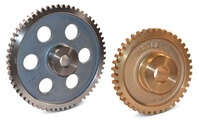
Worm Gears
A worm gear is a cylindrical worm that meshes with a larger gear called a wheel. The worm gear transmits power through right angles on non-intersecting shafts. The worm needs several revolutions to drive the large gear through a single revolution. Worm gears produce thrust load and are suitable for high shock load applications but offer very low efficiency.
We work closely with the leading manufacturers to provide gearing solutions to meet the requirements of your unique applications.
If you have any questions, write us via live chat (one of our team members will answer your questions), give us a call, or send us a quote request. The HVH team is always ready to help you.
 1(866)577-4040
1(866)577-4040
or
Worm Gears
Manufacturers
What is a Worm Gear
A worm gear is a mechanical component that plays a crucial role in power transmission. It consists of a cylindrical worm that meshes with a larger gear called a wheel or worm wheel. The unique feature of worm gears is that they transmit power at right angles on non-intersecting shafts, which makes them ideal for specific applications.
How Worm Gears Work
The operation of worm gears involves the rotation of the worm to drive the worm wheel. The worm, with its helical thread, meshes with the teeth of the worm wheel. As the worm rotates, it transfers rotational motion to the worm wheel. Interestingly, the worm requires several revolutions to drive the larger gear through a single revolution. This characteristic imparts a mechanical advantage to worm gears, allowing them to achieve high reduction ratios.
Efficiency is a crucial factor when considering worm gears for any application. Due to the sliding contact between the worm and the worm wheel, frictional losses occur, leading to lower efficiency. Manufacturers use various methods, such as high-quality materials and improved designs, to enhance the efficiency of worm gears.
Advantages and Disadvantages of Worm Gears
Worm gears offer several advantages, making them suitable for various applications. They provide high reduction ratios, ensuring smooth and precise power transmission. Additionally, worm gears can handle significant thrust loads, making them ideal for applications with high shock loads. Moreover, they have a self-locking feature, preventing the back driving of the system.
However, worm gears also have some limitations. One of the significant drawbacks is their relatively low efficiency compared to other gear types. This inefficiency leads to energy losses in the form of heat during power transmission. Therefore, proper consideration of efficiency is crucial while selecting a worm gear for specific applications.
Applications of Worm Gears
Thrust Loads
Worm gears are well-suited for applications that involve thrust load. The design of the gears allows them to handle significant axial forces, making them suitable for heavy-duty and high-shock load applications.
High Shock Loads
Worm gears can absorb and distribute shock loads effectively. This makes them valuable in applications where sudden and intense forces are common, such as in heavy machinery and industrial equipment.
Factors Affecting Worm Gear Performance
Several factors impact the performance of worm gears. Proper gear pairing, material selection, lubrication, and maintenance are critical to ensuring optimal performance and longevity. Mismatched gear combinations can lead to increased friction, wear, and reduced efficiency. Engineers must consider the gear materials, pitch, and helix angle to ensure a reliable and efficient gear system. Additionally, the choice of lubricant plays a vital role in reducing friction and wear, improving overall efficiency.
Conclusion
Worm gears are indispensable components in power transmission systems, offering distinct advantages in specific applications. Their ability to transfer power at right angles on non-intersecting shafts makes them suitable for various industries and machinery. While they may have some limitations, proper engineering, maintenance, and lubrication can optimize their performance. As technology progresses, we can expect to see even more innovative uses of worm gears in diverse fields, further improving industrial efficiency and productivity.






